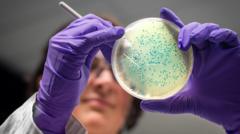Can AI Create Revolutionary Antibiotics to Combat Superbugs Like Gonorrhea and MRSA?

Artificial Intelligence and the Future of Antibiotics: A New Frontier in Medicine
In recent years, antibiotic resistance has escalated into a severe global health crisis, with drug-resistant infections now responsible for over a million deaths annually. The emergence of superbugs such as methicillin-resistant Staphylococcus aureus (MRSA) and drug-resistant gonorrhea has led to an urgent demand for new antibiotics. A recent breakthrough from researchers at the Massachusetts Institute of Technology (MIT) offers a glimmer of hope, as they reveal that artificial intelligence (AI) has successfully designed two new potential antibiotics. These compounds have shown promise in laboratory and animal tests, marking a significant advancement in the ongoing battle against antibiotic resistance.
The Role of Artificial Intelligence in Antibiotic Discovery
Traditionally, the discovery of new antibiotics has been a slow and costly process, often taking years to move from the conceptual stage to clinical application. However, AI is changing the landscape of drug discovery by enabling researchers to analyze vast amounts of data rapidly and identify promising compounds more effectively. The MIT team’s approach involved training AI algorithms to understand the chemical structures of existing antibiotics and their effects on various bacteria. This allowed the AI to generate entirely new molecular designs that could potentially tackle resistant strains of bacteria.
How AI Designed New Antibiotics
The researchers explored a staggering database of 36 million chemical compounds, including those that exist and those that have yet to be synthesized. By using generative AI, the team was able to create antibiotics specifically targeted at gonorrhea and MRSA. The design process included two main strategies:
- Fragment-Based Design: The first approach involved searching through a library of chemical fragments, each consisting of eight to nineteen atoms. The AI identified promising fragments and built upon them to create new antibiotic candidates.
- Free-Reign Design: The second approach allowed the AI to generate completely novel compounds from scratch without predefined starting points.
This innovative methodology not only expanded the range of potential antibiotics but also ensured that the designs were distinct from existing drugs, reducing the chances of redundancy in treatment options.
Laboratory and Animal Testing: Early Successes
Following the design phase, the leading antibiotic candidates underwent rigorous testing in laboratory settings and on infected mice. The results were promising: the newly synthesized compounds effectively killed the targeted bacteria. This early success underscores the potential of AI to revolutionize antibiotic discovery by providing new avenues for drug development.
Challenges Ahead: Refinement and Clinical Trials
Despite the initial success, the newly designed antibiotics are not yet ready for clinical application. Researchers estimate that further refinement and testing will take an additional one to two years before they can enter clinical trials. The process of ensuring that these drugs are safe and effective for human use is crucial and often involves significant resources and time. As Dr. Andrew Edwards from the Fleming Initiative notes, while AI has the potential to enhance drug discovery, the traditional rigorous testing for safety and efficacy remains essential.
The Economic Implications of Antibiotic Development
One of the significant barriers to developing new antibiotics is the economic model surrounding their use. Ideally, new antibiotics would be used sparingly to maintain their effectiveness, which poses a problem for pharmaceutical companies seeking to recoup their investment. As Prof. Chris Dowson points out, the challenge lies in creating drugs that are financially viable while also being necessary for public health. The paradox of needing effective antibiotics but limiting their use complicates the financial incentives for development.
Looking Ahead: A Second Golden Age of Antibiotic Discovery?
Researchers at MIT are optimistic that the advancements in AI could herald a "second golden age" of antibiotic discovery. The ability to design new antibiotics rapidly opens up possibilities for counteracting antibiotic resistance, which has long been a significant concern in the medical community. With the continuous evolution of bacteria, the need for innovative and effective treatments is more critical than ever.
Frequently Asked Questions
What are the main challenges in antibiotic discovery today?
The primary challenges include the slow and costly traditional methods of drug discovery, the evolving nature of bacteria leading to increased resistance, and the economic model that discourages the development of new antibiotics due to their intended limited use.
How does AI improve the antibiotic discovery process?
AI enhances the antibiotic discovery process by analyzing vast datasets to identify promising compounds, designing new molecules rapidly, and predicting their effectiveness against various bacteria. This efficiency can significantly reduce the time and cost associated with traditional methods.
What implications does antibiotic resistance have on global health?
Antibiotic resistance leads to higher medical costs, prolonged hospital stays, and increased mortality rates. It poses a significant threat to global health, making previously treatable infections dangerous and requiring the development of new treatments.
When can we expect to see new antibiotics from AI in clinical use?
While the newly designed antibiotics have shown promise in laboratory settings, they require further refinement and testing, which could take one to two years or more before they are ready for clinical trials. The timeline for actual clinical use will depend on successful testing outcomes.
What role does collaboration play in antibiotic research?
Collaboration among researchers, pharmaceutical companies, and regulatory bodies is crucial for advancing antibiotic development. Working together can help streamline the discovery process, share resources, and address challenges that arise in testing and manufacturing new antibiotics.
The potential for AI to revolutionize antibiotic discovery is immense, and the recent advancements from MIT highlight a new era in combating drug-resistant infections. As we continue to understand and harness the capabilities of AI, the medical community may find itself better equipped to address one of the most pressing challenges in healthcare today. Could this technological breakthrough pave the way for a new generation of lifesaving antibiotics? #AIinMedicine #AntibioticResistance #FutureOfHealthcare
Published: 2025-08-14 15:07:01 | Category: technology



